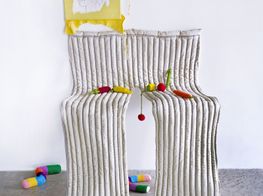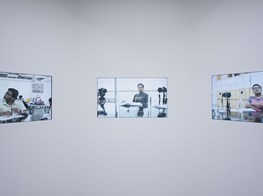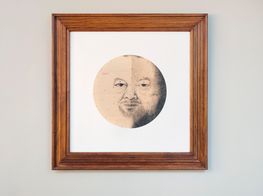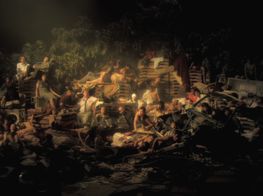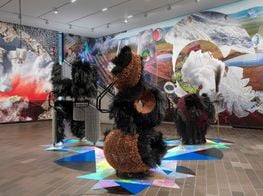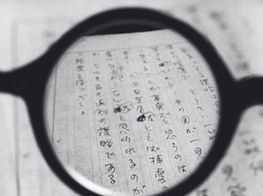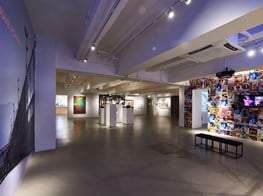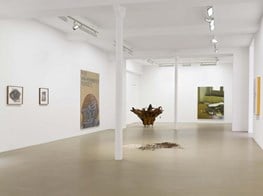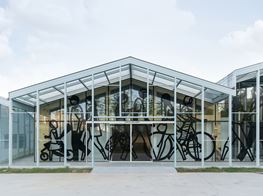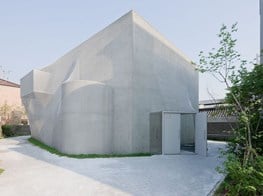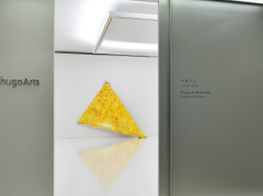Ghosts, Spies And Grandmothers At Mediacity Seoul 2014
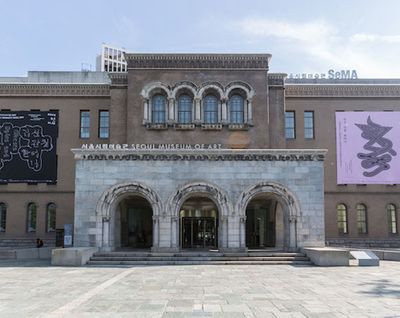
Much has already been said about the fast-paced development and break-neck modernization of Asia but what has been largely forgotten in these breathless accounts is the importance of its history. In order to understand contemporary Asia one needs to look into the past, look more closely at its regional diversity and draw connections to local versions of the Cold War with the rest of the world.
For a country best known for its mobile phones made by conglomerates Samsung and LG and K-Pop singers through the sensationalism of Gangnam Style sung by Psy, Ghosts, Spies, and Grandmothers is an unlikely title for a biennale, especially one that was originally conceived to reflect on the “media-frenzy characteristics of Seoul.” Yet, led by the artist and film director Park Chan-kyong, the 8th edition of the Mediacity Seoul Biennale is notable for numerous changes, becoming the first organized directly by the Seoul Museum of Art rather than an external agency.
While Park, who was awarded the Golden Bear at the Berlin Film Festival for his short film Night Fishing (shot entirely on an Apple iPhone), is no stranger to “media,” he has chosen to calibrate this biennale differently, focusing not on the technical applications of media in art but rather unpacking the larger discursive layers that intersect contemporary culture. In this way the framework stretches to include vital interests much nearer to his own, including subjects as broad as the Cold War and traditional Korean religious culture. This approach has allowed him to expand his interests to include subjects that have been forgotten, or silenced when discussing Asia’s economic miracle—effectively entwining multiple subjects he felt intuitively shared a root. In doing so he has expanded not only the purview of media and art, but the dialogue around the cultural sphere of Asia, examining its past and traditions, its spiritual and religious influences, and its contemporary definition both home and abroad.
One powerful way he has done this is evident in the words used in his title. By evoking “Ghosts” Park unapologetically alludes to the many failures in Asia’s modernization that still, he implies, occupy and haunt its psyche. His aforementioned interest in and continued exploration of the historical and sociological remnants of the Cold War, another seminal period of history, is clearly framed by the word “Spy”; and finally the word “Grandmothers” somewhat abruptly reminds us of the speed of social change and the powerlessness felt by those who were pawns during the vicissitudes of Asia’s years of colonization and war.
Utilizing his broad historically mediated framework Park has organized a dynamic exhibition that opens more doors than it closes. Nowhere is this better illustrated than in his choice to open the Mediacity Seoul Biennale with a performance of Seoul Sae-nam Gut, a shamanic ritual for the dead. Dressed in an elaborate costume and using sacred chants, songs and dances, traditional shaman Lee Sang Soon celebrated the commencement of the exhibition by cleansing the site of Seoul Museum of Art which was originally used by the Court of Justice and the Supreme Court. An affecting performance that reminded all present of the many historical tragedies of Korea’s not-so-distant past and also ritually opened the Biennale by giving solace to those present. Choosing to look to the past to open such a forward thinking event, the performance highlighted Park Chan-kyong’s intent to bring attention to tradition while at the same time, spiritually and metaphorically calling upon the ghosts who still possess so many untold stories.
This polyvalent approach both underlies Park’s curatorial position as well as challenges the viewer to draw their own connections. Indeed, by creating at times competing critical narratives, Park successfully avoids the kind of overly generalised positions often associated with biennials while still insisting on criticality and the analogy of the Cold War as a metaphor for cultural complexity. About this approach Park has stated that he wanted to “pluralize the idea of the Cold War,” and the selected works in the exhibition parallel his observation that the Cold War was not just an isolated event and clash of ideologies between the US and Soviet Union but a much more complex collision of regional actors coupled with the history and experience of colonialism which is still influential today.
Examples of these cultural echoes include Che Onejoon’s Mansudae Master Class, a 3-channel video and installation showcasing the North Korean business Mansudae Art Studio, which produces statues and portraits of the North Korean leader as well as Mansudae Overseas Projects—its international division—which constructs public monuments and buildings in African countries. The resulting monuments and buildings in Africa strongly evoke North Korean socialist realism and Che’s work shows the little known evolution and impact of this history. Another video and installation titled The Guerrillas of Cu Chi by The Propeller Group conveys the theatricality of the weapons of war. Cu Chi, a district in Vietnam well known for its underground tunnels built by the Viet Cong during the US-Vietnam War, has now become a tourist destination with a shooting range where tourists can pay to shoot the same guns used during the war. Filmed in the shooting range, The Guerrillas of Cu Chi positions the camera facing the tourists thereby making the viewer the target of the lethal and loaded weapons.
Eric Baudelaire’s The Anabasis of May and Fusako Shigenobu, Masao Adadchi and 27 Years without Images captures the two remarkably similar stories of May, the daughter of Fusako Shigenobu–leader of the extremist left-wing faction the Japanese Red Army who led an anonymous existence while living incognito in Beirut, and Adachi, a filmmaker who abandoned commercial filmmaking in Japan to join the extremist Japanese Red Army in exile in Beirut. Filmed on Super 8mm, the panoramas of Tokyo and Beirut form a backdrop for May and Adachi’s voices and memories as they speak of exile, politics, cinema and everyday life, their parallel lives are powerful reminders of forgotten memories.
Like many others in the exhibition, these powerful works sift through the dense cultural layers and ask what informs the past and to what extent can we judge or proclaim a singular history when so many stories remain untold.
While I cannot possibly include a description of even a fraction of what is included in the diverse spectrum of Mediacity Seoul Biennale, one work that stands out is Bae Young-wha’s installation of hundreds of celadon pieces in her installation titled Autonumina-Ten Thousand Years’ Sleep, Seonbawi Inwang Mountain which has been placed next to a late Joseon Dynasty painting titled Immortals’ Feast on Yoji Pond. Inwang Mountain, located in the heart of Seoul, is both a sacred and secular place where shamans and Buddhist monks reside, apartments and military camps have been built, and day hikers visit daily. On the other hand the Immortals’ Feast on Yoji Pond depicts a banquet for Taoist gods inside an imaginary landscape. These works serve to remind us that “mountains, islands, jungles, and the sea” (which Park titled the subthemes for the biennale) are the forgotten or excluded sites within this urban landscape that provide a backdrop for such stories and they are the sites where the many darker and more sublimated histories of Asia converge.
Ghosts, spies, grandmothers as well as mountains, islands, jungles and seas each in their way offers a filter to see that which is “not seen” beneath the high-rise development and signs of progress so prevalent throughout Asia. The exhibition seeks to provide as broad an overview as possible but it is limited by the perhaps inevitable focus on Korea whereas cultural histories of other Asian countries are difficult to find in the exhibition. For example, documentary photographs of Korean shamans by Kim Soo-nam may provide rich detail into some of the traditional customs in Korea but parallel traditions and insight into the rich overlapping metaphors of media and communicating with the dead—a tradition that is prevalent in other Asian countries—was not included.
Still, the exhibition successfully draws focus on various sociological and political histories of more contemporary Asia. These range from Mahardika Yudha’s video which candidly looks at the morning rituals of workers in accordance to company rules that still serve a memorandum of the military ruling in Indonesia, to the film of Nina Fishcher & Maroan el Sani which observes the aftereffects of the nuclear disaster in Fukushima, Japan by framing the parallel fears and uncertainties experienced by the Japanese in the wake of Nagasaki and Hiroshima.
This year’s Mediacity Seoul is a dense and kaleidoscopic presentation of contemporary Asian history. Every story presents narratives combining complex layers framing the way history is unfolding in real time. One of the strengths of the installation is the vast amount of supporting documentation and photography accompanying the many artists’ works. These archives provide a reference reminding the viewer of what can be seen and not seen, depicting Asia in its physical as well as spiritual and supernatural guises. In this pluralistic reading of Asia, one can sense that not even Park’s seven titles and subtitles Ghosts, Spies, and Grandmothers: mountains, islands, jungles and seas are enough to capture its dramatic history or address the disparate situations that affect the region today


